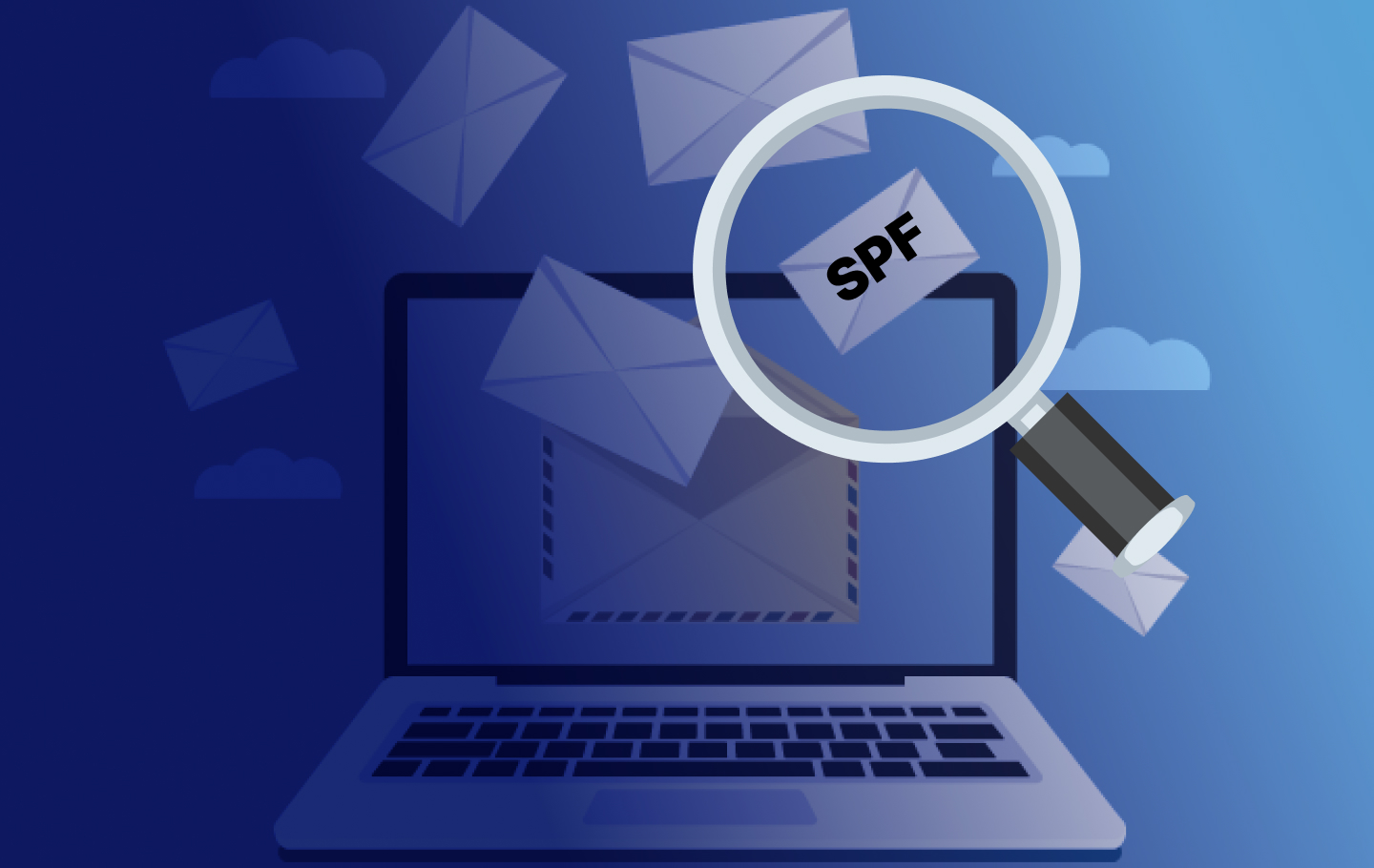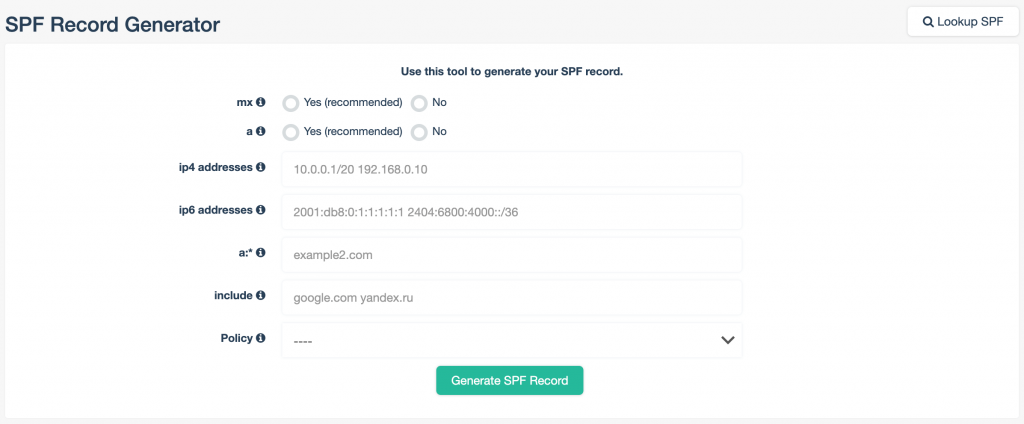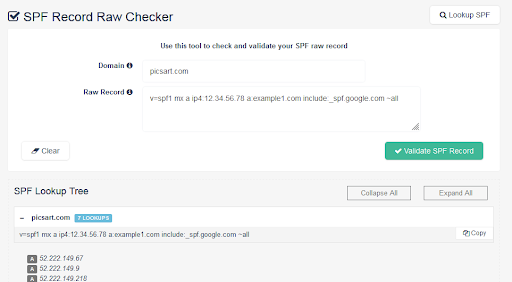SPF records can help ensure the safety of your domain by protecting against phishing attacks and improving email delivery, which is the most important thing about SPF records. Although SPF is easier to enable than DKIM and DMARC protocols, it’s a good idea to do a quick SPF record lookup to ensure you enabled it correctly. You can check SPF records manually. However, the process can be complex and intimidating. It’s much easier to use an SPF checker to ensure that your SPF records are properly installed. EasyDMARC offers a free SPF record generator that you can use to create your desired SPF record to ensure your domain’s security. Here is how to use the free SPF lookup tool on EasyDMARC to check SPF records for your domain.
What is SPF?
Sender Policy Framework, or SPF, is a technique used to verify and authenticate email domains to prevent hackers from sending emails on your behalf. It’s a technical email authentication process that protects senders and receivers against spoofing and phishing, which occurs when someone attempts to gain sensitive information from your email account. More specifically, it defines the way an email is sent through an authorized server to detect email forgery. SPF was created to supplement a basic protocol called SMTP that sends emails as SMTP itself does not have any authentication processes.
Also, SPF works by establishing a set of rules that receiving email domains must use to verify that incoming emails are sent from an authorized host within that domain’s administration. There are several steps involved in the SPF process. First, an email domain publishes a policy or set of rules that must be in place for an authorized user to send emails from a particular domain. The set of rules or policies is called an SPF record. This is listed in the domain’s generalized DNS records. Follow the link to find out how to optimize SPF record?
Next, when a mail server receives an email message, it looks up the set of rules or SPF records for its return-path domain in its DNS. The incoming receiver then compares the set of rules of the sending receiver with the rules listed in the SPF record. Lastly, the receiving email domain uses these rules to decide whether to accept the email, reject it, or flag it (place it in spam).
Do I Need an SPF Record?
You definitely need an SPF record if you are operating a business or commercial email domain. This helps verify that any email that comes from your domain is actually from you. A properly configured email authentication process such as SPF is also an important step you can take to improve your email delivery. However, it helps to implement DKIM and DMARC in your DNS for further protection.
What’s The Difference Between SPF, DKIM, and DMARC?
SPF, DKIM, and DMARC are all email authentication programs that enable different parts of the email protocol process. All protocols address similar issues. Here is a breakdown of each:
- SPF allows users to set up rules that all IP addresses must follow when they send email from a certain domain
- DKIM sets up an encryption key and digital signature that checks all outgoing emails and verifies those were not spoofed or hacked
- DMARC works off of DKIM and SPF policies. It unites the two protocols into one framework. Users can enable DMARC checks to do one of three things: accept all emails that come through, send questionable emails into spam (quarantine), or block questionable emails altogether (reject).
How To Check SPF Records With EasyDMARC Tools
EasyDMARC has several free tools on our website to help you ensure proper email authentication. You can use the SPF record lookup or the SPF record generator to check SPF record and create them for free.
With the SPF record lookup tool, you can do the following:
- Check SPF text for the domain in your DNS
- Determine if SPF records specifications (RFC7208) correspond with elements and syntax
- Also, check all IP ranges and IP included in your SPF
- Verify published SPF records and their hierarchy trees for DNS lookups
- Check SPF records for their length so that they do not exceed 450 octets (this may lead to SPF record validations errors)
- Verify for multiple SPF records in your DNS (this leads to a “permerror,” according to the SPF’s rules)
- Check for “10 DNS lookup” limitations (this also causes a “permerror,” according to SPF rules)
- Also, check SPF records for recursive includes (this causes “permerror”)
- Check SPF records to ensure they don’t exceed “2 Void DNS Lookups” (this leads to SPF record validation errors)
What do you need to know about SPF records? SPF record generator can help you if you want to:
- Read all about your SPF’s mechanisms and terms (this can help you easily create an SPF record)
- Create an SPF TXT record and publish it in your DNS
- Validate your SPF records and text correspondences before publishing them in DNS
EasyDMARC also has a tool for a free SPF record raw checker on our website:
- Validate your SPF TXT record before you publish it in your DNS
- Check your SPF records and text correspondence specifications
- View your SPF records and their tree hierarchy with validations
- Also, view all nested IP ranges and IPS included in your SPF’s tree hierarchy
- Check for multiple SPF records (this causes an error in SPF specifications)
- Then check for SPF record’s “10 DNS Lookup” limitations (this also causes an error)
- By SPF record lookup tool check your SPF against recursive includes (this leads to error)
- Also, check SPF records against “2 Void DNS Lookup” limitations (this leads to permerror)
Enter your email address or domain in the SPF lookup toolbox. After you enter your domain, press enter. You will be taken to a page that has a button that says “SPF Lookup.” Press this button and EasyDMARC will reveal all the information about SPF records on your domain. If you click on the next tab called “SPF record generator,” it will allow you to generate your SPF record. Use this tab to create an SPF record. Lastly, you can click on the third tab to conduct an SPF raw checker.
Additionally, you can use the EasyDMARC website to troubleshoot if you are having problems with your SPF records. The website can help you figure out and solve “too many DNS lookup” tissues that cause permerrors. Many companies use several different email service providers. Each provider usually requires its own email authentication process. Providers that support SPF processes can include SPF records in their DNS. However, this can cause your SPF records to quickly reach the 10 DNS lookup limit, which results in permerror errors. This error means that the published records within that domain cannot be read correctly. The domain’s authorized user must solve the issue.
How Do I Correct a Failed SPF Record Message?
An important thing to know about SPF records is that you can reduce the number of DNS lookup errors you come across by replacing the elements in your configurations that are causing the DNS lookups. This includes “a,” “ptr,” “redirect,” “include,” and “exists.” You can replace these items with elements that do not cause lookup problems, such as “ip6” and “ip4.” This process is known as SPF flattening.
Here are some problems with SPF flattening to be aware of:
- Reports that are included in your DNS can be changed over time, especially if you use multiple email service providers
- SPF texts do not have infinite lengths. If a flattened SPF record has more than 450 characters, the record must be split up and managed separately
- SPF flattening can exceed 10 DNS lookup limitation but needs to include SPF macroses instead of simple IP ranges in the DNS
When you deploy DMARC records, the goal should be to identify existing email authentication problems, such as those in the quarantine or reject policies. For example, after enforcing DMARC policy to a reject or quarantine policy, new legitimate emails may still appear. This usually occurs when a marketing person uses another more familiar product in their messages. You can lose the emails that were sent from the new source. This also wastes money. To reduce this loss, you can have SPF notify you and make corrections quickly to reduce errors.
Conclusion
Using SPF can help secure your domain to ensure that no one is sending emails from your domain on your behalf. It’s the first of three steps before enabling DKIM and DMARC that allows for the best protection and improved email delivery on your account. Without SPF, your domain is more prone to hacking, spoofing, and phishing.
Some email domains already have SPF set up on their behalf. You can check this by using EasyDMARC’s SPF lookup tool. This free feature is listed on the EasyDMARC website and is easy to use. All you have to do is enter your IP or email domain. The SPF checker will check to see if any SPF records are enabled on your behalf. If you do not have any enabled, you can use the SPF record generator to create some.





